|
|
|
October 2013
|
Vol 3, Issue 6
|
|
Garden Notes

|
|
|
|
|
|
Greetings from Christianson's!
|
"Change always comes bearing gifts."
- Price Pritchett
It's happened. We've spun full circle back to October, that glorious time of autumn joys - time to pick apples, stack firewood, nibble on candy corn, and burrow into cozy quilts.
Best of all, it's time to break out the big tools and go to work in the garden. After months of envisioning new possibilities and improvements, we can finally start digging, dividing, sharing, and rearranging. In a nutshell, it's time for some changes.
Rearranging plants doesn't get much press, but it's one of the gardening jobs I relish the most (and I know I'm not alone). Moving plants lets us be equal parts naturalist, artist, and athlete - and when those parts are all working together, there's no stopping us.
Here are a few telltale signs that you are a garden rearranger:
- You wander the garden with a shovel in one hand and an uprooted plant in the other, looking for just the right place to tuck it in. You do this again and again. For hours.
- After stopping to scrutinize one particular spot for a few moments, you and your shovel dive in. Plants trade places, debris is flying, and suddenly you're 'in the zone.' At this point, family members know it's time to stay out of your way and put dinner on hold.
- Your neighbors sometimes spot you in your garden, after dark, wearing a headlight. You just have to put in that one last plant...just one more...
- By the time you finally call it a day, your knee-pads are askew, your gloves are soaked, your pruners are missing, and you couldn't be happier.
My fondness for rearranging began in my childhood bedroom. Its contents were a big puzzle that could be reconfigured in countless ways. It was so energizing to be starting fresh, solving design challenges, and rediscovering lost treasures. And I loved that gratifying 'Ta Da!' moment when the last piece clicked in place.
Rearranging living things in the garden gives us all that and more. There are so many variables to consider: soil and light conditions, the size of each plant, fragrances, textures, colors, seasonal changes. It's mentally challenging, physically demanding, and altogether exhilarating! Moving plants reconnects us to our gardens in ways that might not happen otherwise.
More often than not, improvements are made and plants are rescued. I recently went to move a plant and was surprised to find that its roots were still packed tightly in the shape of the nursery pot. It was downright pitiful. It had been like that all summer - still alive and not complaining, but not living fully. As I gently pried apart the matted root ball, I thought about the lessons to be learned from that little plant. Of all the plants I move this year, that one will have a special place in my heart, and in my garden.
This seasonal ritual of moving plants is full of such lessons. Small changes can create larger ripples. Less can be more. Ruffling our roots can stimulate growth. May you discover these and many more treasures in your garden this month.
Happy October, everyone!
 Eve Boe, Garden Notes Editor
|
|
 |
|
Where To Find Us
| |

15806 Best Road
Mount Vernon, WA 98273
Map and directions
www.christiansonsnursery.com
360-466-3821
1-800-585-8200
Open Daily
9 am - 6 pm
Winter Hours
begin November 3:
Open daily 9 am - 5 pm
Weekly Radio Broadcast:
Sunday Mornings at 10:30 am
The Garden Show
with John and Mike
KAPS AM 660
Voted Best Greenhouse and Nursery
in Skagit Publishing's
People's Choice Awards for
2010, 2011 and 2012
NW Flower & Garden Show
"People's Choice Award 2011"
|
|
|
Autumn & Winter Calendar Highlights
|
Saturday, October 5 12:30 - 2 pm: Fresh Cider Pressing 1:00 - 2 pm: 'Growing in Winter with a Tower Garden' (complimentary)
The Skagit Valley Festival of Family Farms is coming up this weekend, October 5 and 6, from 10 am to 4 pm both days. While you're out and about on Saturday, swing by Christianson's for fresh pressed cider and take a class on growing winter edibles. Saturday, October 12 11 am - noon: 'Shrubs and Trees for Fall and Winter' Sunday, October 20 1 pm: Fall Color Walk with John Christianson (complimentary) 2 pm: High Tea at the Granary, La Conner Flats Saturday, November 2 11 am - noon: 'Dramatic Designs for Winter Containers'
Saturday and Sunday, November 2 and 3 Art's Alive! and Holiday Open House Saturday, November 9 1 pm: Conifer Walk with John Christianson (complimentary) 2 pm: High Tea at the Granary, La Conner Flats Sunday, November 10 1 - 2:00 pm: 'Bonsai for Beginners' Saturday, November 16 11 am - noon: 'Gardening with Wet Soils' Saturday, November 30
10 am to 3 pm: Arrival of Father Christmas
11 am to 4 pm: Holiday Wreath Making
noon to 5 pm: 18th Annual Holiday Tea
December 1 - 24
9 am - 4 pm: Independent Wreath Making
Saturday, December 7 ** NEW DATE **
1 pm: 'Swans of the Skagit'
Saturday, December 14
11 am: 'Snow Geese of the Skagit'
Please visit our website for detailed event descriptions
|
The Garden in October
by Rachel Anderson
| |
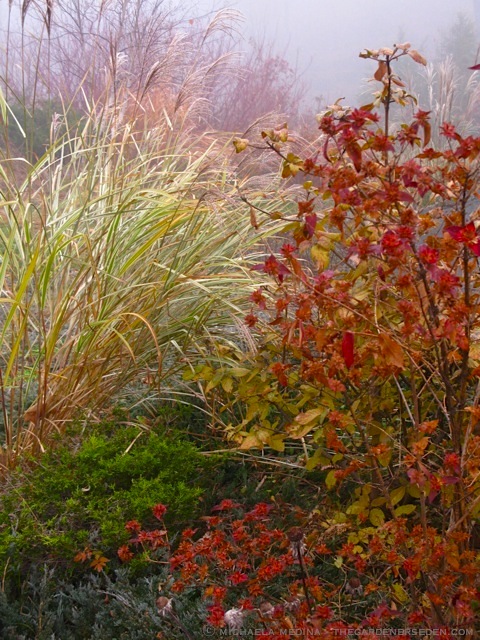 | |
Photo from The Gardener's Eden
|
October in the garden is so quintessentially autumnal for me. Mornings are cool and drippy with dew (if not down right soggy from the rain the night before) and spider webs are draped artfully from shrub to tree, each strand beaded with moisture. Colors stand out vividly despite being shrouded in mist and fog, and the blades and tassels of grasses sigh with the slightest breeze. The songbirds have mostly moved on by now and are replaced by the full silence of fall. It's sort of like the deafening silence of a room once the party is over and the guests have all gone home. Don't allow the winding down to fool you, though. There's a lot to do in the garden before the first frost hits and winter sets in for the long haul.
In the ornamental garden:
- Pull those weeds you've been ignoring! With the return of the rainy season upon us, the soil is refreshed and yields the roots of weeds more easily than dry soil.
- Cut back any perennials that are tired looking or beginning to go dormant, especially spring blooming herbaceous perennials like peonies, columbine, and baptisia. I like to leave perennials like asters, echinacea, and rudbeckia because they are still showing a bit of color. When the petals have finally faded and fallen away, the seed heads are excellent forage for wild birds.
- Leave your grasses alone for now. They have a very long season of interest that extends clear into winter.
- Spread compost or bark as a mulch, being careful not to put it up against the trunks of trees and shrubs. Mulching in the fall is an excellent way to protect plants during the winter, plus it adds organic matter to the soil and helps keep weeds under control. On top of all that, it looks fresh and beautiful!
- Rake fallen leaves. If you're lucky enough to have a maple, oak, or other deciduous trees in your yard (or your neighbor's yard), then you have a fabulous source of FREE MULCH! This is a valuable resource. If the leaves are large (like our native big leaf maple) then you may want to chop them up a bit so they decompose faster, and also so they don't clump together and create a slimmy, slippery mat. Adding leaves in the garden - both ornamental and vegetable - will add minerals and organic matter to the soil, while at the same time protecting plants and keeping down weeds. Just be sure the leaves you use are not diseased or buggy. Also steer clear of walnut leaves as they contain growth inhibitors that prevent seed germination and stunt the growth of existing trees and shrubs.
- October is a great time to move or divide perennials. It's also a good time to move small shrubs or trees if you've decided they're not where you'd like them after all. They'll have all winter to establish new roots to support next season's growth.
- Empty summer planters and hanging baskets. Clean and store your pots for next year, or refill them with fall and winter in mind.
- If your hydrangeas are beginning to turn the wrong color (i.e. blue to pink, or more commonly pink to blue), now is a really good time to adjust your soil ph for next year's flowers. If you want electric blue flowers, add aluminum sulfate. If you want pink flowers, add lime. Hydrangeas have the amazing ability to change color depending on the soil ph and sometimes will have both pink and blue flowers on the same plant! If you've never had your soil tested, it's not a bad idea to do so before you do too much soil tinkering. The WSU extension agency will be able to steer you in the right direction, or you can pick up a home ph test kit at the Nursery. The kits aren't exact science, but they will give you an idea.
- Plant bulbs! We've got our best selection in at the nursery. Just think of those bright cheerful colors after a long, grey winter. You'll be so glad you went through the trouble of digging all those little holes! If you live in deer or bunny country, there are some great bulb varieties that the critters will usually leave alone, such as Allium, Fritillaria, Scilla, Galanthus (snowdrops), and Erythronium (tooth violet). If fact, because the bulbs of Frittillaria are so stinky, they actually work to repel ground dwellers like moles and voles.
- Start paperwhites in pots indoors for flowers and fragrance around Thanksgiving. We have 3 varieties to choose from, including a new one called 'Ariel', which is supposed to have a more compact growth habit. Paperwhites usually take about six weeks from time of planting until bud and bloom. Plant successively for cheerful indoor color all winter long. Hyacinths also force well. Forced bulbs make wonderful hostess gifts for the holidays, so plant lots and plan to give some away!
- Select Amarylis bulbs. We have a great selection to choose from by the end of October. They take a little longer to bloom than paperwhites, usually 8-10 weeks, so make sure to leave enough time before the holidays.
- Don't forget about the birds! Empty out your bird feeders and give them a good cleaning if you haven't done so in a while. Make sure to clean bird baths too, and keep them full.
In the veggie garden:
- Harvest late apples, pears, and Asian pears.
- Pick the rest of your tomatoes. This was a fabulous year for tomatoes, wasn't it?! I'm a little sorry to see it end.
- Pull weeds and any veggie plants that are through producing.
- Sometime towards the end of October is the time to plant garlic. Mulch with straw or leaves. When you start to see the little green shoots peeking out, remove the mulch and side dress with a slow release vegetable fertilizer.
- Generously thin any seedlings that were sown in September. It's important that overwintering veggies get good air circulation to help with disease resistance.
- If you have veggie beds that are laying fallow this winter and you didn't get around to sowing a cover crop, make sure to use a mulch of some sort to help protect against compaction from the pounding rain and erosion of vital nutrients. Straw (NOT hay) is excellent, as are fallen leaves.
Although the party that is summer is now over, there's still a lot to look forward to in the garden. There's a change of scenery which gives us a different perspective and allows us to see what maybe we were missing before. Enjoy your new view!
To download a printable copy of this article, click here
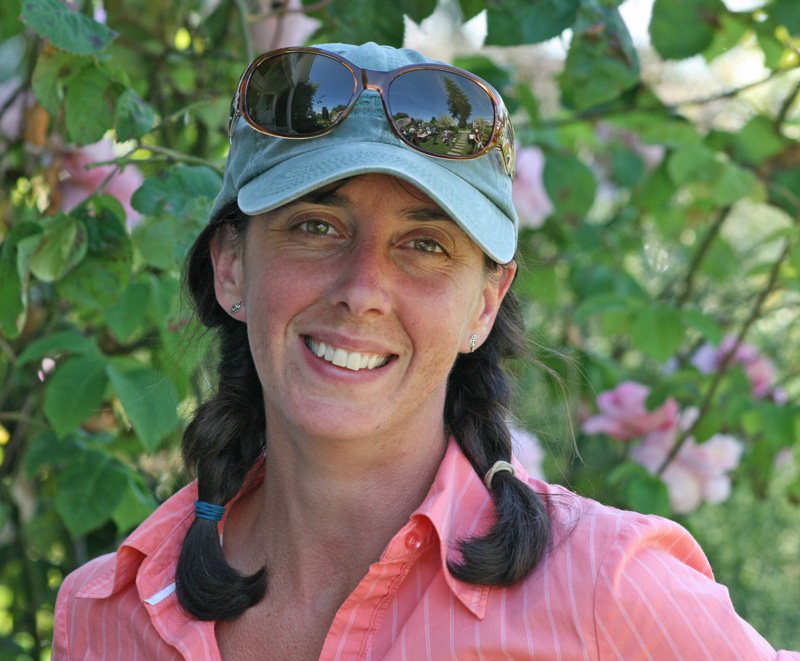
Rachel has been gardening since childhood, thanks to her mom, and has been part of the team at Christianson's since 2002. She's a Certified Professional Horticulturist with a passion for roses and vegetable gardening. Rachel and her family enjoy gardening together and now share their urban garden with a menagerie of ducks, chickens, two cats, and a dog.
|
|
Seasonal Specials
|
OCTOBER HIGHLIGHTS
Halloween Decorations and Party supplies
Plants for Fall and Winter Containers
Fall containers all planted up and ready to display
Bulbs!
Trees and Shrubs for Fall Color
it's a great time to see a wide variety of deciduous trees
and shrubs in all their gorgeous fall colors
OCTOBER SPECIALS
October 1 - 17
Conifer Sale - 25% off
tall and dwarf evergreens, including spruce, fir, cypress, pine, juniper
October 18 - 31
Hedging Sale - 25% off
laurel, boxwood, photinia, Japanese holly, Leyland cypress, privet and arborvitae
|
|
Staff Picks
| |

This month our 'Staff Picks' come from Heidi Klepper, a Certified Horticulturist with 23 years of experience in the nursery business and a Christianson's staff member for the past 14 years. Heidi has a special interest in rhododendrons, Japanese maples, unusual evergreens, and bulbs.
Here are a few of Heidi's favorite picks for October:
Bulbs!
The Nursery has a wide selection of common and uncommon spring-blooming bubs, many of which are deer and bunny resistant, including tulips, allium, narcissus, crocus, iris reticulata, fritillaria, camassia, galanthus, hyacinth, hyacinthoides, seilla, and dogtooth violet. Of all the bulbs, here are some of my favorites:
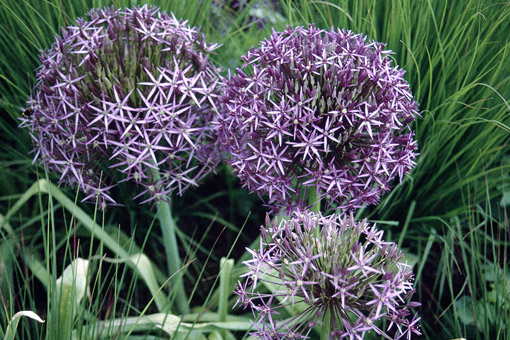 | |
Allium cristophii
|
Allium: This is a 'make you smile' sort of plant with its big ball-shaped flowers that look like polka dots in the landscape in the late spring and summer. Among the bigger flower-ball varieties, Allium cristophii is one of my favorites. There are also two unusual varieties that are very fun: 'Hair' has sprigs of green leaves popping out of aerial bulbils (so it looks like a full head of hair) and 'Schubertii,' which looks like a giant Fourth of July sparkler.
Narcissus: This is one of my favorite, must-have bulbs. Narcissus are deer resistant, most have a wonderful fragrance, and they come in a wide assortment of sizes and color combinations. The Nursery has a great selection of mixes as well as individual varieties.
 | |
Species tulip 'Chrisantha'
|
Species tulips: Also known as 'wild tulips,' species tulips are long-lived "perennial" tulips that naturalize well, especially if you give them a little fertilizer in the fall and spring, and let them to die down naturally (in other words, you can deadhead the faded blooms but don't cut back the leaves). Species tulips tend to be on the small side (4 -6") and will thrive in tough, dry conditions.
Darwin tulips: This is another type of "perennial" tulip that comes back reliably for about five years (assuming you don't cut the leaves off after blooming). Darwin tulips are among the tallest tulips there are - usually in the range of 16 - 18" - and have a huge flower, so it's a good idea to plant them where they will be protected from high winds. Because of their height and large, colorful blooms, Darwin tulips are great in cut bouquets.
 | |
Bearded iris 'Superstition'
|
Bearded iris: The Nursery has a great selection of bearded iris in a bunch of fun colors and color combinations. I think the flowers are as pretty as orchids but they are easier to grow.
Hyacinth: This is one of my favorites for fragrance, especially when planted in outdoor pots and pathways near doorways. You can also "force" them to bloom indoors in mid-winter. The Nursery has a great selection of hyacinth bulbs and we even have some chilling to help give you a head start on indoor forcing.
Paperwhites: This is the quintessential bulb to force for indoor color and fragrance, especially during the holidays and winter months. I recommend getting several varieties and planting them at intervals so you will have weeks of enjoyment.
Garlic: The Nursery has four types of garlic - Silver Rose, Early Italian Purple, German Red, and Spanish Roja. Pick your favorites or experiment with all four. October is the time to plant your garlic for summer harvesting.
Here are a couple more items that come in handy when planting bulbs:
Bulb food and bone meal: The Nursery carries EB Stone Organics Bulb Food and Organics Bone Meal. It's always a good idea to use one or the other when planting bulbs.
Hori Hori knife: This is perhaps our most popular tool. Among its many uses, it works great for planting bulbs. It even has a ruler on the blade for correct planting depth.
Here's a great article with tips on planting outdoor bulbs.
This article was written by Jane Billinghurst and published on the website
of the WSU Skagit County Extension Master Gardeners in October 2011.
Here are a few more highlights in Heidi's list of fall favorites...
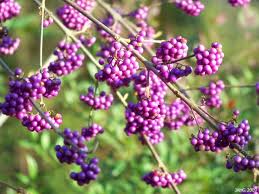 | |
Callicarpa bodinieri 'Profusion'
|
Callicarpa bodinieri 'Profusion' (Beautyberry):
This is one of my favorite perennial shrubs. It has long, arching branches and yellow-green fall foliage but it's best known for the amazing clusters of glossy, neon purple berries that drip from its branches in the fall and winter. It provides great cuttings for flower arrangements, and the seeds and berries are much appreciated by the birds.
Clerodendron trichotomum: This is a vigorous deciduous shrub or small tree that grows 10 - 20' tall and has fragrant tubular white flowers that bloom from late summer into fall. The flowers are followed by small, metallic blue fruits (berries) that are surrounded by a red calyx. Clerodendron trichotomum is sometimes referred to as the 'Peanut Butter Tree' because its flowers smell like peanut butter.
Grasses: October is a great time to stop by the Nursery and look at all our ornamental grasses. They are at their best this time of year with their flower heads in full plumage, and many are turning colors. I especially enjoy using grasses for color in fall containers.
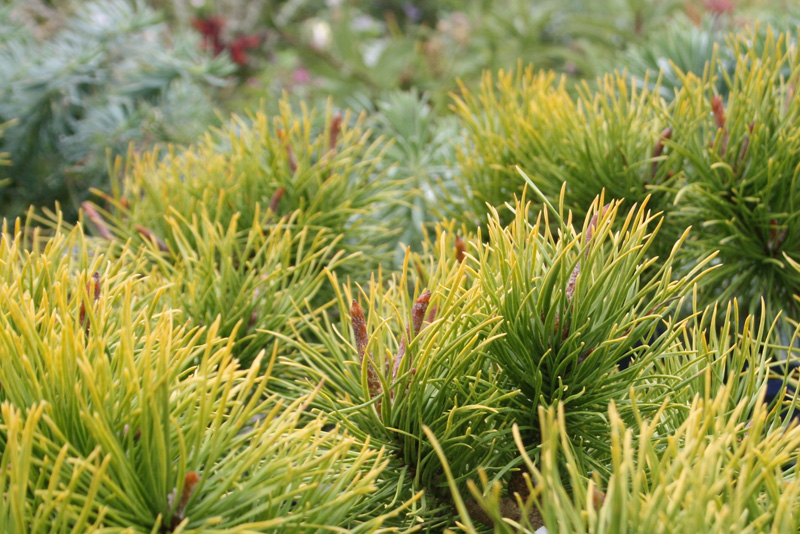 | |
Pinus contorta 'Chief Joseph'
|
Conifers: We just received a big order from one of our best conifer growers so it's the perfect time to come in and see a great selection of unusual and beautiful conifers. Especially striking are the "Wintergold" pines: mugo 'Wintersonne' and 'Carstens', strobus 'Louie', sylvestris 'aurea', virginiana 'Wates Golden' and the premium Pinus contorta 'Chief Joseph'.
|
|
October Classes & Events
|
Saturday, October 5
Fresh Cider Pressing with John Christianson
12:30 - 2 pm
Come enjoy some apple cider freshly made on our antique press. This is the weekend of the Skagit Valley Festival of Family Farms, so make a day of it with tours at the numerous working farms in this beautiful region, including La Conner Flats right next door to Christianson's. Here at our Nursery, John and Toni Christianson have made a point of preserving the picturesque and functional buildings of the Valley's rich agricultural heritage; come see our granaries, potting shed, classic 1946 greenhouse, and 1888 Schoolhouse. You can also read more about them in the History section of our website.
Saturday, October 5
Growing in Winter with a Tower Garden
1 - 2 pm
(reservations requested - complimentary event)
Are you interested in growing your own fruits, veggies, and greens this winter, but you wish your garden was closer to your backdoor or out of the weather? If so, a hydroponic Tower Garden may be the perfect solution. Guest speaker April Barnett will show you how easy it is to plant a Tower Garden for winter so that you can grow a wide range of edibles, from seed to harvest, in a small space and convenient location - your backyard, deck patio, courtyard, or even indoors!
Saturday, October 12
Shrubs & Trees for Fall & Winter
11 am - noon
(reservations required - $5 class fee)
A glorious palette of colors and sensuous array of textures can delight you in the garden during fall and winter, and Ani Gurnee of Aulos Design has inspired ideas to help you make the most of the cool seasons. She'll guide you with plant choices, tips for pruning to enhance seasonal beauty and advice for siting (everyone should have a Sarcococca near an entry door to get that wonderful fragrance). Ani's artistic eye helps you see the possibilities: sinewy silhouettes contrasted with muscle-y bulk; shreddy bark and wispy twigs; the joy of brilliant sumac and sourwood leaves.
Sunday, October 20
Fall Color Walk with John Christianson
1 - 2 pm (reservations requested - complimentary event)
Join John Christianson to enjoy and learn about the fabulous fall colors of leaves and berries in a dazzling array of plants. The walk begins in our Schoolhouse Garden, and then you'll stroll past our llamas, sheep and chicken coop on the way to the mature garden at La Conner Flats. Following the walk, plan to have High Tea at the Granary at La Conner Flats. This delightful tea features sandwiches, scones, fruit and dessert. Space is limited; call 360-840-1163 for reservations ($24 per person).
For class and garden walk reservations,
please call us at 360-466-3821 or 1-800-585-8200
Visit our website for more details about all the classes and events coming up at the Nursery this fall and winter
|
|
Closing Thought...
|
"I'm so glad I live in a world where
there are Octobers."
- L. M. Montgomery, Anne of Green Gables

|
|
|
|
Garden Notes Editor:
Eve Boe, Public Relations
Christianson's Nursery & Greenhouse
360-466-3821
|
|
|
|
|
|